Like so many people during the current pandemic lockdown, I’ve started to get to know my neighbourhood much more closely on daily walks for exercise from my home. One of the elements of Toronto’s everyday vernacular architecture I’ve always found interesting is the former corner shops embedded within residential neighbourhoods in the older parts of Toronto. Once upon a time these were the first stop for regular goods and sometimes services, not to mention local news and gossip, for nearby residents who could walk to them daily. But with the advent of widespread car ownership and supermarkets, many of them declined and were converted to become purely housing.
The need to address climate change and congestion, and more recently the sudden reorientation towards working from and shopping near home caused by the COVID-19 pandemic, have stimulated talk about reorienting our lives more closely around the neighbourhood we live in. Even before the pandemic, Paris mayor Anne Hidalgo had begun talking about the “15-minute city” where we can live, work, play, study, and shop all within a 15-minute walk. With the added experience of the pandemic forcing us to stick to our neighbourhoods, the idea of having more of our shopping, services, and workplaces near where we live has become all the more front-of-mind.
Current zoning, however, prohibits any use other than residential on streets within residential neighbourhoods, pushing all retail, service, and office uses to main streets. Corner stores that have maintained commercial use all along are grandfathered, but I’m told that once they are converted to residential use, they can’t go back. And, as we will see below, there are a fair number of these former commercial properties hidden within neighbourhoods in the older parts of the city.
Maybe one small nudge towards Toronto as a “15-minute city” could be to designate all of these former corner shops inside neighbourhoods as automatically, as-of-right, eligible to be reconverted to commercial uses. They probably would not become corner shops again — those still wouldn’t be viable in most cases. But they could be any other kind of commercial use too, whether retail, services, or offices – a barbershop, a lawyer’s office, a coffee shop or specialty store (or a coffee shop and specialty store), a co-working space, maybe even a startup. They also have the advantage of potentially being convenient live-work spaces, with living space on the upper floor; alternatively, the upper floor could supply a much-needed residential rental unit. It’s a change that would be relatively subtle, since it would only affect a tiny fraction of the buildings in a neighbourhood.
Ideally most employees and customers would be local and be able to walk or bike to these locations. But these buildings are generally also not far from transit. Once the pandemic ends, if driving is necessary, there will usually be parking spaces available on nearby streets during the day when some locals drive to their own work. Meanwhile, keeping people in or bringing people to the neighbourhood would provide additional business for local shops and restaurants, and bring additional “eyes on the street” to the area during the day.
Any reconversions would be a slow process, especially given how desirable housing is in the older parts of the city, so this would just be a very small step. But it might give a little nudge towards better integrating mixed uses into some older neighbourhoods without too much disruption.
In the meantime, my local walks have given me the opportunity to look for and observe these former corner stores more closely. Here are some of the indicators I’ve noticed for spotting former corner stores in residential areas. I’ve stuck to those inside neighbourhoods rather than ones on minor arterials like Pape Avenue, where they are less unexpected. These examples are all within a few kilometres radius of where I live, off the Danforth.
A few corner commercial buildings are still in use, of course. Some are still corner shops.
Others have innovative new uses, such as cafes, or even little offices.
But there are many more that have been converted to residential over the years. Some have not changed much yet; others have long been absorbed into residential use and their former commercial identity is quite disguised.
One of the dead giveaways of a former corner store is the angled corner door.
In some cases, these have even been covered over, but an angled wall on a corner building is a sign of a former store.
I found one case where you can still spot the former step up to the door.
An alternative indication is a recessed door.
The full-width single ground-floor window, once used for displaying goods and giving a view into what the store has to offer, is also a sign.
A paved-over front yard is also a clue that a building was once used for commerce.
Sometimes, corner retail shops were somewhat disguised, looking like a regular house on the upper stories but with commercial elements on the ground. But, often, former corner retail shops are simpler and boxier in their build than the regular houses on the street. They have flat roofs that stand out from the peaked roofs of their residential neighbours, and doors flush to the ground with no front porch.
Corner commercial buildings are usually detached, but sometimes they’re part of a semi-detached pairing. In those cases, they often sport the same ornamentation as their attached twin, but the ground floor of the corner building has some commercial features.
Sometimes the attached building, one in from the corner, has also been used for commercial purposes.
The ground-floor extension to the curb is also sometimes a feature — possibly a case where a building was originally residential and later converted to retail. But most corner commercial buildings appear to have been purpose-built.
Sometimes there’s still residue of retail visible, like signs or stickers.
Some have been greatly changed, but the indicators discussed above suggest to me that these were once corner commercial buildings too.
Some streets that are apparently residential but designated by the City as collectors (PDF), such as Logan Avenue and Sammon Avenue, have these former stores on practically every block. On these streets, former corner shops often appear on two of the four corners of an intersection — perhaps they once offered different services.
But there are others hidden here and there on purely local streets, too. In these cases, they usually seem to be the only one on the intersection.
If anyone has further knowledge about or experience of these in-neighbourhood former and current commercial spaces, please share it in the comments.
Addendum: more images of former and current corner stores in other parts of Toronto, photographed by Charles Marker, can be found in Fonds 485 of the City of Toronto Archives.

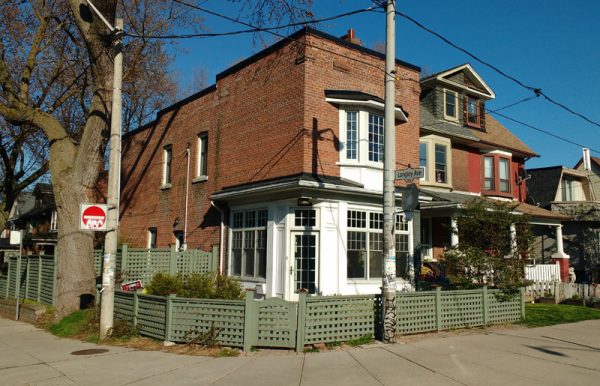




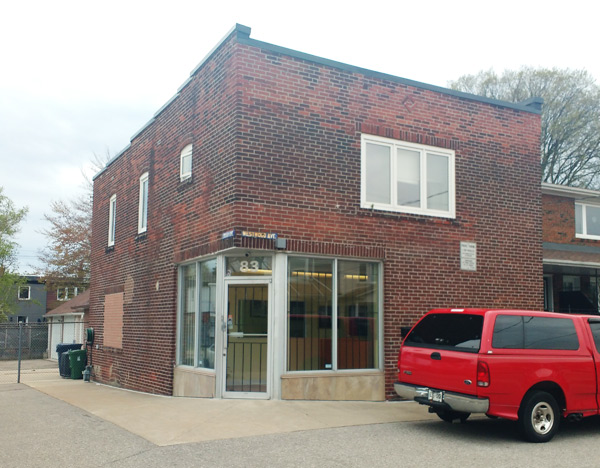
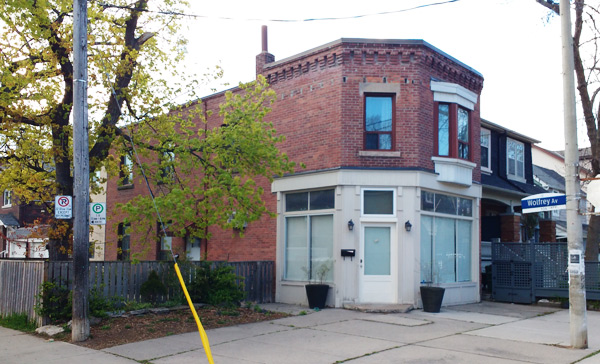
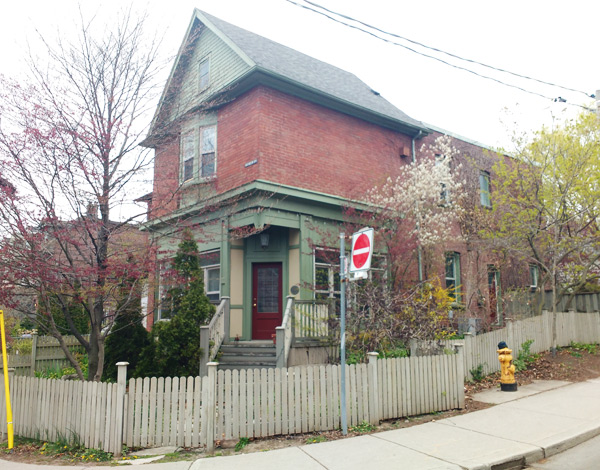
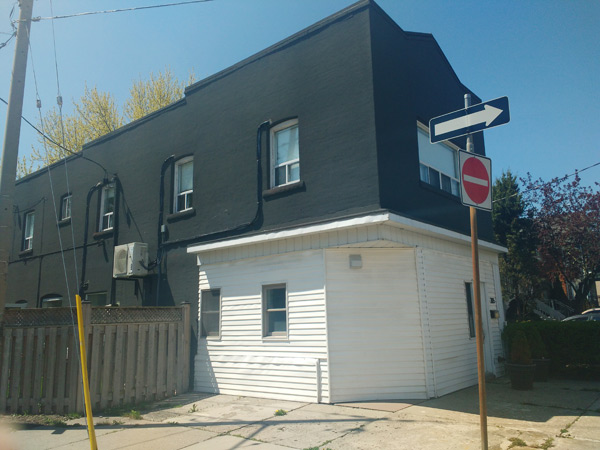
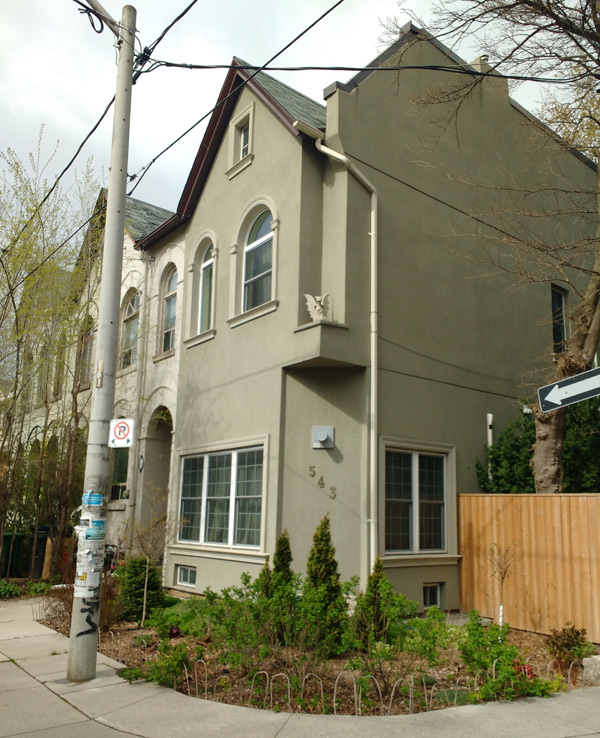
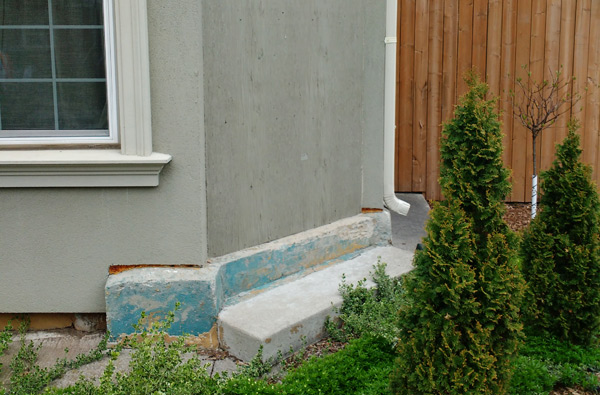
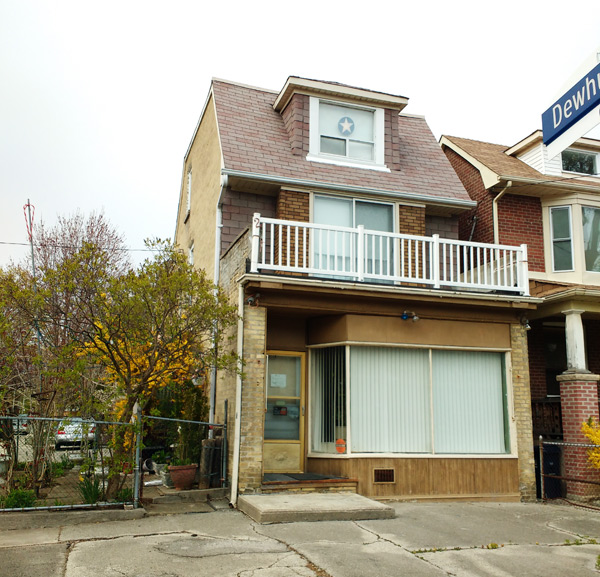

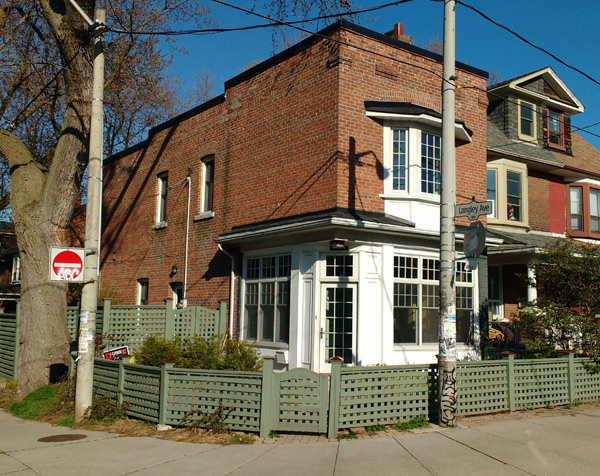
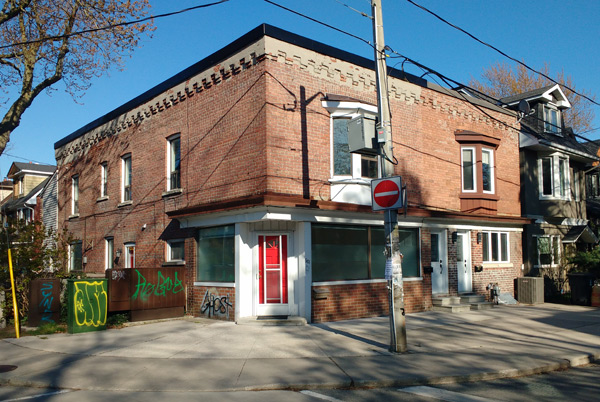
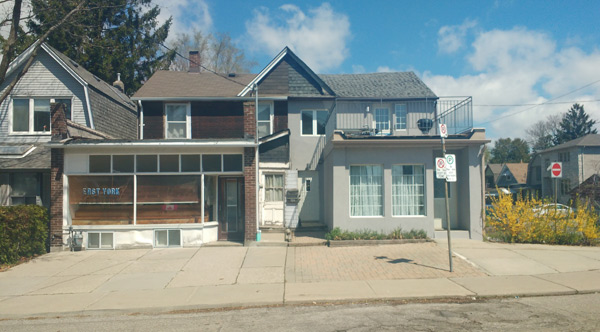
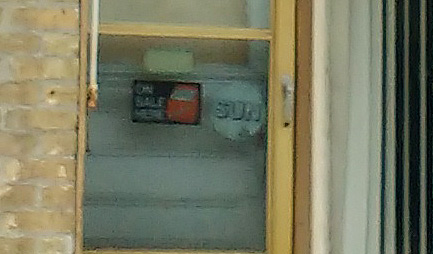

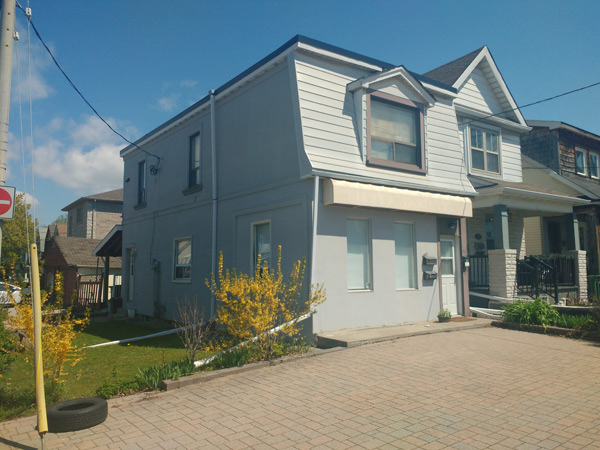
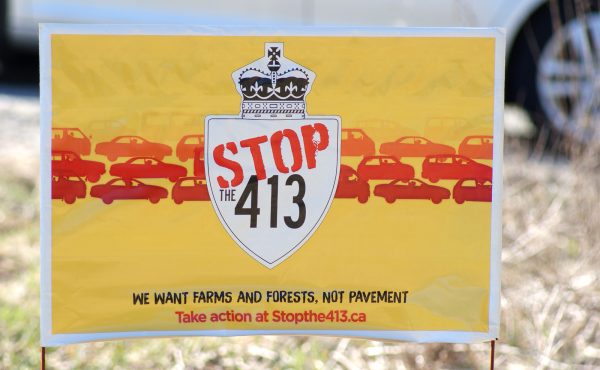


10 comments
Hallam/Lappin in the West End has tons of these. Some mention of it in this previous Spacing article: https://spacing.ca/toronto/2019/12/13/torontos-missing-middle-should-be-built-along-collector-roads/
I’d love for Mimico Avenue to return to commercial. It could be a vibrant hub of activity for the neighbourhood.
I’m following up with some of the interesting information people are sharing with me about some of these buildings.
Dave Till suggested looking at old Toronto directories available online ( https://twitter.com/davetill/status/1265000307123195904). A random search revealed that 543 Logan Ave. (the greenish house where the corner door is walled up) was Bird’s Cleaning & Pressing in 1949.
Sarah Elton shared that the semi-detached with the red door was, she thinks, a plumbing supply shop, and south of that was an ice house (https://twitter.com/SarahAElton/status/1264953010125504513). She’s also heard there was a bakery on the same street, Logan, which has a lot of these former corner shops (and a few that are still active).
Rich Lafferty shared an example of west side mid-block meat market, of all things (https://twitter.com/mendel/status/1264974444629569538)
Piali Roy let me know that the building on Withrow (first angled door example) was once Sip cafe (https://twitter.com/PialiRoy/status/1264961063453425665), and Toby Lennox added that it moved across Riverdale to become the Riverdale Perk (the cafe photo example) (https://twitter.com/tobylennox/status/1264995584156581889)
I love the little shop between Monarch Park and Little India:
https://goo.gl/maps/skBiQgjaRpZpxSJx7
This needs to be the zoning evertwhere to allow for walkable neighborhoods – live/work zoning everywhere in the old city of Toront/East York.
The Contra cafe at Shaw and Yarmouth. BTW apparently my grandparents ran one of these stores during the (last) Depression
This is the best ever article Dylan. I am at Mimico Royal York and we still have some of these stores. This should go forward to our more progressive councillors. The timing is perfect. If we want to fight for a more human city this is it. I love Spacing and am a follower since the beginning or close
The author briefly touches on this but the major issue is that commercial rent pales in comparison to residential rent, so even if the zoning allowed it I can’t see a situation where a sensible landlord does this for any reason other than essentially acting as a donation to increase neighbourhood vitality. Sure it’s slightly cheaper to build commercial space but it’s certainly not economically sensible to convert residential space to commercial. This may change over time but, especially with COVID accelerating retail’s death, sadly, I don’t think this is a realistic possibility within my lifetime (I am 30)
Great piece, Dylan! It’s such a loss to urban texture and quality of life that so many of these are gone.
Architectural historian Mark Fram sent me a link to a map from 1915 that seems to capture many of the locations I noticed: https://maps.library.utoronto.ca/datapub/digital/HE_4509_T62_A4_V2/img010.jpg (black = retail and office business).
Also, from information people have sent me on Twitter, it seems like many of these buildings were converted to residential relatively recently – often after 2000 or so. Likely related to the rapid increase in value of residential properties in the older parts of the city since the beginning of the century. But a shame to lose these mixed uses, especially given they often appear to have been used for commercial purposes for a good century.